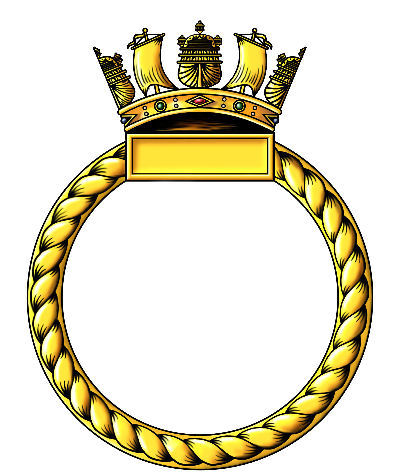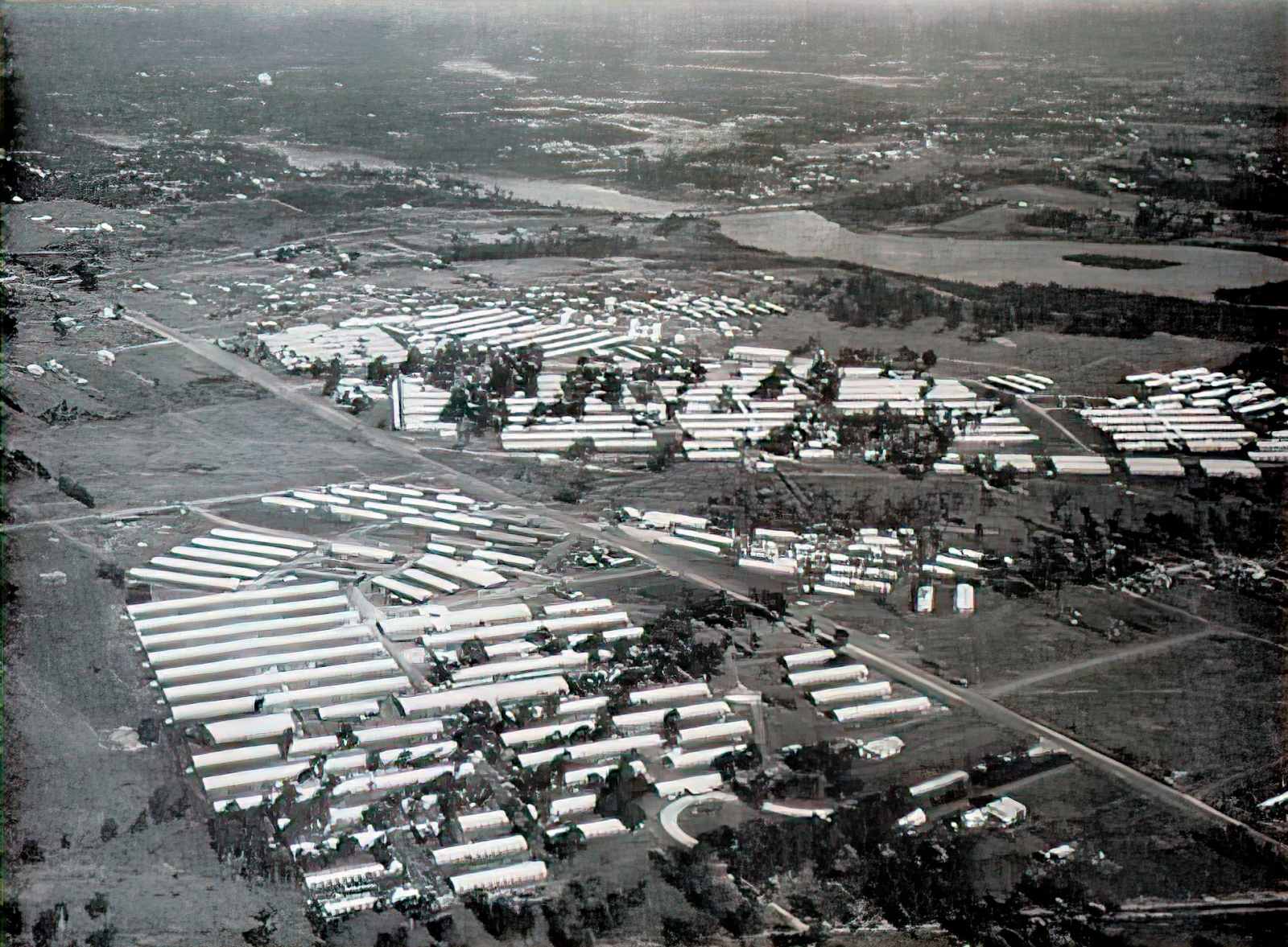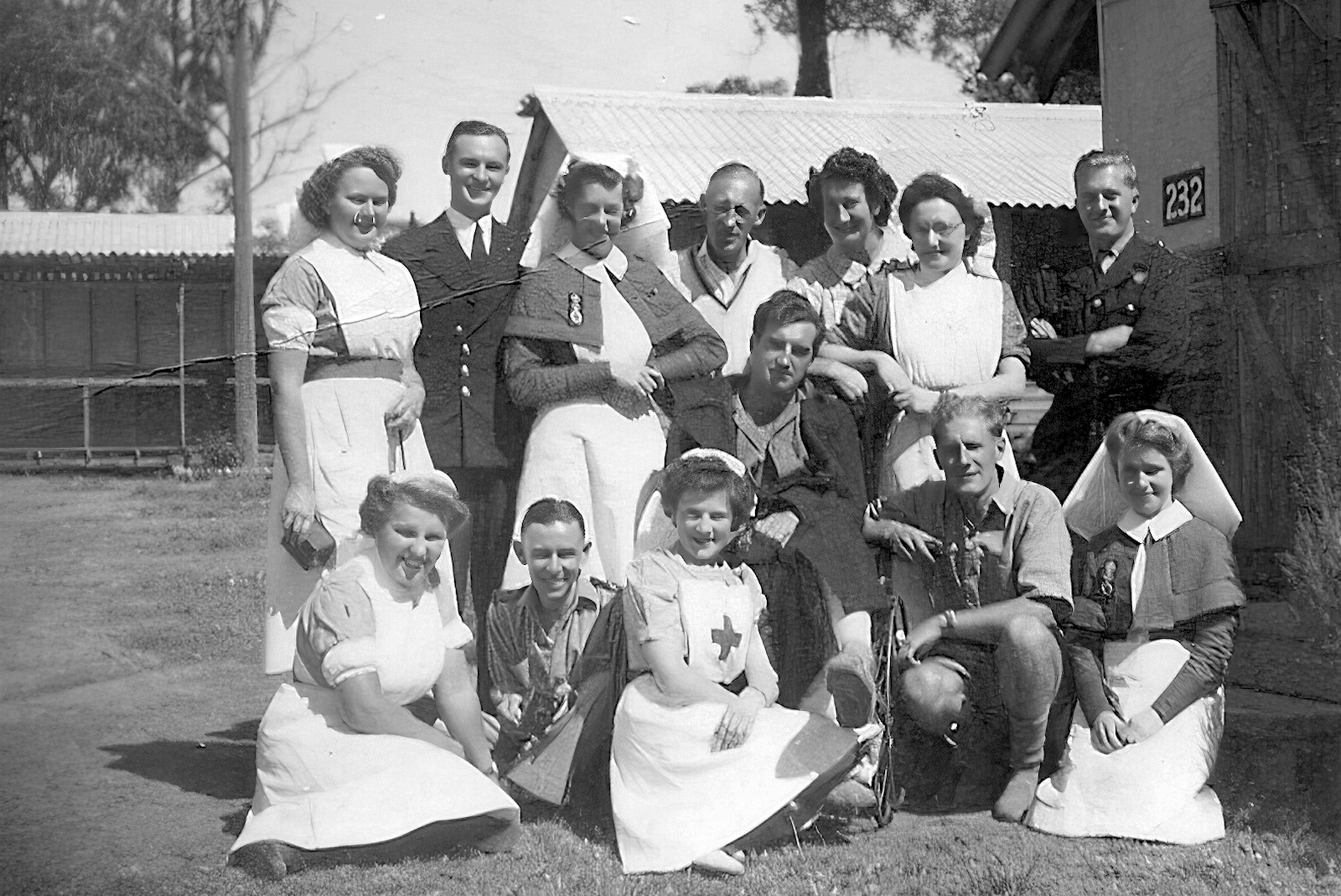R.N. Auxiliary Hospital

No badge issued for this establishment
Battle Honours
None
Specifications
Location
Herne Bay, Sydney
Commanding Officers
Surg. Rear Admiral J. A. Maxwell, CB, CVO, OBE, MD, BCH, FRCS
Related items
None
Reminiscences
None
Gallery
None
R.N.A.H. Sydney

Royal Naval Auxiliary Hospital at Riverwood, HIerne Bay on the outskirts of Sydney
Establishment of a Naval Auxiliary Hospital
When the decision was taken to deploy a British Fleet to operate in the Pacific fighting against the Japanese plans were put in motion to establish shore based medical facilities in Australia, the location of the headquarters and main base for the new British Pacific Fleet.
The Royal Navy was to take over part of the site of the former U.S. Army 118th General Hospital at Herne Bay, twelve miles outside Sydney. The large hutted hospital which consisted of 490 timber barracks-type buildings covering an area of 170 acres could house a total of 4,250 beds and accommodate up to 1,250 patients and 3,500 staff, had been vacated in October 1944 and remained disused until the RN requested its use.
Preliminary preparations for its occupation were made by an advance party of medical staff and 45 nursing sisters who left England for Australia on November 20th 1944. This party included 35 members of the Queen Alexandra Royal Naval Nursing Service under the charge of Principal Matron, Miss K. Baker; they arrived in Sydney on December 20th 1944 1945.
The British Pacific Fleet was due to arrive in Sydney on February 10th 1945 and the hospital needed to be able to meet its requirements by this date. The hospital site at HIerne Bay was officially occupied by the Royal Navy on January 10th 1945 under the command of Acting Surgeon Rear Admiral J. A. Maxwell, CB, CVO, OBE, MD, BCH, FRCS. [1] The hospital was ready and equipped to receive patients within seven weeks, being open for patients on January 15th.
Preliminary planning was for a 2,000 bed hospital. The living conditions were of necessity arduous during the first few weeks, many of the huts needed repairs; complete refurnishing was necessary and was complicated by slow production and adherence to the Australian field scale, which was much lower than the scale for equivalent British units. Provisional equipment had to be obtained from Australian sources and was in short supply.
Long delays in receiving casualties from the forward area
At the time the BPF began operations against the Japanese in March 1945 there was a shortage of hospital ships, only OXFORDSHIRE was on strength and she was to be a base hospital ship at Leyte in the Philippines, the fleet’s most forward anchorage. Any hospital ship making the return passage back to Australia evacuating casualties faced an eight day voyage each way from the Fleet’s Intermediate Base at Manus in the Admiralty Islands so to help speed up recovery of casualties R.N. Auxiliary Hospital, Sydney proposed ferrying patients from the forward operating area by air and the R.N. Medical Air Evacuation Unit No.1 was instigated in April. The unit consisted of a small sick quarters for the night staging of patients manned by one naval medical officer and one sick berth petty officer, with six flying teams each composed of one R.N. nursing sister and one SBA (sick berth attendant) . Its function was to fly approximately 20 patients a day from Manus to Sydney, a distance of 1,600 miles.
Evacuation flights carried special medical packs and equipment specially made up for use in aircraft. Aircraft flew first to Milne Bay, then to Townsville and Brisbane, before landing at Sydney. The nursing sisters and SBAs were accommodated in the American Hospital at Manus, and made a round trip about every eight or nine days. Each sister completed six round trips before the unit closed down. Later, a second unit was trained and formed in order to extend the service to Eniwetok (Marshall Islands), but owing to the early cessation of hostilities, never came into effect. At the beginning of October 1945, the service was turned over to an R.A.F. Casualty Air Evacuation Unit. During its period of operation R.N. Medical Air Evacuation Unit No.1 transported 556 patients.


Left: A naval nursing sister of the R.N. Medical Air Evacuation Unit tends to patients on board a Dakota transport plane. Right: Personnel unloading casualty, probably at Mascot airfield, Sydney before being transported to the RN Hospital at Herne bay image. Images FL15984359 and FL15574716 State Library Victoria collection
Reconstruction work progresses and capacity grows
The establishment soon grew to a strength of 21 Doctors, 62 sisters and 240 V.A.D.s (Voluntary Aid Detachment) and 90 Wrens, mainly cooks and mess stewards under the charge of Second Officer. M. S. Jobson. Work to reconstruct the hospital buildings continued during February to May, and admissions capacity grew with each new batch of works being completed; 172 patients were admitted during February and by time Admiral Sir Bruce Fraser, GCB, KBE, C in C British Pacific Fleet visited on May 31, 1945, 1,400 beds were ready for occupation, well in excess of the 786 patients admitted during June. By this time the hospital was beginning to function smoothly, though still plagued by a shortage of clinical equipment, and administration was hampered by lack of office equipment, stationery and typewriters.
The first seaborne casualties from the forward area arrived in Sydney on June 7th on board the New Zealand hospital ship MAUNGANUI, she had been operating as Auxiliary Naval Hospital at Leyte, sharing the duty with OXFORDSHIRE, whish delivered casualties to Brisbane on the same date.
By the end of June 1945, the hospital had 990 beds occupied by 535 medical and 455 surgical patients. At this time the ultimate maximum bed strength had been reduced from 2,000 to 1,750.
On July 7th the Duchess of Gloucester visited the hospital and was shown around the facilities by the principal matron Miss Kathleen Baiter and Admiral Maxwell.

July 17th 1945: Nursing sisters and VAD's line the route of the Royal car during the visit of the Duchess of Gloucester to R.N. Auxiliary Hospital, Hearne Bay, Sydney. © IWM A 30084
Post War P.O.W. reception and rehabilitation centre
When Japan Surrendered on August 15th the hospital’s focus changed to the treatment and convalesce of recovered prisoners of war and internees. The hospital became, in addition to being the base hospital for the British Pacific Fleet, a reception and rehabilitation centre for prisoners-of-war released from Japanese prison camps, as well as the evacuation centre for recovered prisoners-of-war awaiting passage to the United Kingdom.
Due to operational and political constraints this evacuation and repatriation of POWs and Internees could not begin until after the surrender of Japanese forces in each former colony. Some of the first recovered POWs were embarked at Hong Kong on the day of the signing of the surrender in Tokyo, September 2nd, when the RN hospital ship OXFORDSHIRE and New Zealand hospital ship MAUNGANUI arrived having sailed from Subic Bay in the Philippines. OXFORDSHIRE arrived at Sydney con September 22nd carrying a large contingent of recovered prisoners of war and internees; next of kin however were not allowed to meet the ship when she docked, all patients were taken to the R.N. Auxiliary Hospital, Sydney, where next of kin were permitted to meet them. The ship had embarked 334 ex-prisoners of- war; of these 36 per cent were suffering from pellagra, 23 per cent from malaria, 16 per cent from beriberi, 3 per cent. From ascariasis (a type of roundworm), and the remainder from various forms of dysentery. Seven patients died during the voyage and one woman was confined. However, with careful nursing, the majority of the ex-prisoners-of-war had made a remarkable recovery within a few days, several gaining as much as 10 to 14 lbs. in weight.
Another batch of recovered POWs and internees arrived in Sydney on September 27th on board the CVE RULER. She had been present in Tokyo Bay during the official surrender signing on September 2nd and was transformed into an evacuation ship embarking 375 passengers on the13th mostly released POWS but there were 25 women, 15 children and several civilians who had been interned by the Japanese. A further 70 Australian Army ex POWs were embarked the following day before she sailed for Sydney on September 15th. She socked at no, 4 berth Prymont, on the 27th and all passengers were transported to the RN Hospital. RULER reported a marked improvement in the health of her charges on passage. STRIKER arrived at Sydney on October 9th with more former POWs and internees from Hong Kong and Singapore where she had embarked more recovered Australian POWs and a number of medically unfit but walking POWs transferred from the Hospital Ship GERUSALEME on September 27th.
A second hospital ship, TJITJALENGKA arrived in Sydney from Yokohama on October 12th, having been part of the Allied organisation processing liberated prisoners of war held in internment camps in the Tokyo area. After arrival at the reception Centre in Yokohama liberated British and Commonwealth personnel fit to fly out were taken to an air strip near Tokyo for flights to Manila and onward passage to Australia, those who could go by sea were ferried out to ships in Tokyo bay; those requiring medical treatment were embarked in TJITJALENGKA. Once relieved she sailed for New Zealand and Australia to repatriate her patients.


Left: A group of convalescing service personnel pose with two Naval Nursing Sitters and 5 V.A.D.s outside hut 232, Phot curtesy John Bow. Right: Two V.A.D.s. looking after a group of recovering patients in the sunshine. Image FL1599589 State Library Victoria collection
Rundown to closure and conversion to temporary housing
In the New Year the number of patients received began to fall as the numbers of returned POWs began to shrink and the Royal Navy began to to close its bases in Australia. By mid-May 1946 many of the wards had been closed and were released to the Australian authorities at the start of April, to provide accommodation blocks for displaced families. Twenty-one families were initially settled into converted huts with work underway to convert a further 217 huts. A further 908 buildings would become available once the R.N. Hospital finally closed at the end of May. The largest R.N. Hospital in the world was to become the biggest temporary housing project in post war Australia.
During its 18 month’s in operation R.N. Auxiliary Hospital, Sydney, had received and treated 9,003 Service patients.
The R.N. personnel returned to England in two lifts. A number of staff, including the principal matron, sailed on the troop ship Athlone Castle, but the bulk of them, including Surgeon-Commander D. D. St. Steel-Perkins, R.N., O.C., and Surgeon-Commander W. A. Hopkins, R.N. and the last Female medical personnel in Australia, 9 Q.A.R.N.N.S. nursing sisters, and 50 V.A.Ds embarked on the aircraft carrier INDEFATIGABLE, which sailed for the UK on June 9th.
Last modified: 15 August 2023
Primary information sources
Additional sources:
(1954) Surgeon Commander J. L. S. COULTER, D.S.C., R.N., ‘THE ROYAL NAVAL MEDICAL SERVICE’ London, Her Majesty's Stationery Office - Volume 1'Administraion'
TROVE, digital archive of National Library of Australia various newspapers including;
The Sydney Morning Herald (NSW)
Newcastle Morning Herald and Miners' Advocate (NSW)
West Australian (Perth, WA)
Comments (0)